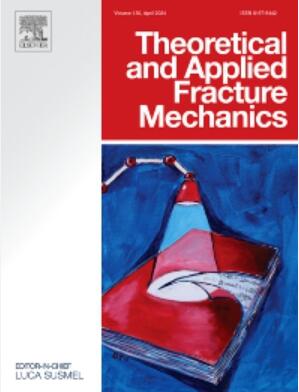Enhanced hyperbolic Drucker-Prager criterion-based phase-field model for the brittle-ductile transition in rock under varying confining pressures
IF 5
2区 工程技术
Q1 ENGINEERING, MECHANICAL
引用次数: 0
Abstract
The investigation of the brittle-ductile transition in rocks is crucial in rock engineering. In this study, we propose an enhanced elastoplastic phase-field model to replicate the mechanical behavior and failure modes of rock under increasing confining pressure. To effectively simulate tensile, tensile-shear, and compressive-shear failures during deformation, we employ the hyperbolic modified Drucker-Prager (D-P) criterion. This criterion approximates the D-P surface with a hyperbolic surface, thus addressing the limitations of the traditional D-P criterion, particularly under tensile-shear stress conditions. Introducing a modified variable damage-driving energy coefficient into the plastic free energy function ensures that a portion of the plastic work propels fracture propagation while the remaining energy dissipates. This modification enhances the physical realism of the phase-field model (PFM). To validate the efficacy of the model in replicating the mechanical behavior and failure modes observed in laboratory experiments, numerical simulations of rock samples containing a single pre-existing crack deformed under uniaxial compression are compared with data from published laboratory experiments that use Digital Image Correlation (DIC) technology. By incorporating confining pressure into the model and analyzing samples containing two pre-existing cracks with varying inclination angles, we find that the model accurately captures the mechanical behavior of rock as confining pressure is increased and as the rock approaches the brittle to ductile transition. We conclude that the presented model shows significant promise for simulating damage, fracturing, and failure in rock engineering projects.
基于改进双曲Drucker-Prager准则的变围压下岩石脆性-韧性相变相场模型
岩石脆性-韧性转变的研究在岩石工程中具有重要意义。在这项研究中,我们提出了一个增强的弹塑性相场模型来模拟岩石在增加围压下的力学行为和破坏模式。为了有效地模拟变形过程中的拉伸、拉伸-剪切和压缩-剪切破坏,我们采用了双曲修正的Drucker-Prager (D-P)准则。该准则用双曲曲面逼近D-P曲面,从而解决了传统D-P准则的局限性,特别是在拉剪应力条件下。在塑性自由能函数中引入一个修正的可变损伤驱动能量系数,以确保部分塑性功推动断裂扩展,而剩余能量消散。这种修正提高了相场模型的物理真实感。为了验证该模型在复制实验室实验中观察到的力学行为和破坏模式方面的有效性,将含有单个预先存在的裂缝的岩石样品的数值模拟与使用数字图像相关(DIC)技术的已发表的实验室实验数据进行了比较。通过将围压纳入模型,并对含两个不同倾角裂缝的试样进行分析,发现该模型能较准确地描述围压增大时岩石脆性向延性转变过程中的力学行为。我们得出的结论是,所提出的模型在模拟岩石工程项目中的损伤、破裂和破坏方面具有重要的前景。
本文章由计算机程序翻译,如有差异,请以英文原文为准。
求助全文
约1分钟内获得全文
求助全文
来源期刊

Theoretical and Applied Fracture Mechanics
工程技术-工程:机械
CiteScore
8.40
自引率
18.90%
发文量
435
审稿时长
37 days
期刊介绍:
Theoretical and Applied Fracture Mechanics'' aims & scopes have been re-designed to cover both the theoretical, applied, and numerical aspects associated with those cracking related phenomena taking place, at a micro-, meso-, and macroscopic level, in materials/components/structures of any kind.
The journal aims to cover the cracking/mechanical behaviour of materials/components/structures in those situations involving both time-independent and time-dependent system of external forces/moments (such as, for instance, quasi-static, impulsive, impact, blasting, creep, contact, and fatigue loading). Since, under the above circumstances, the mechanical behaviour of cracked materials/components/structures is also affected by the environmental conditions, the journal would consider also those theoretical/experimental research works investigating the effect of external variables such as, for instance, the effect of corrosive environments as well as of high/low-temperature.
 求助内容:
求助内容: 应助结果提醒方式:
应助结果提醒方式:


